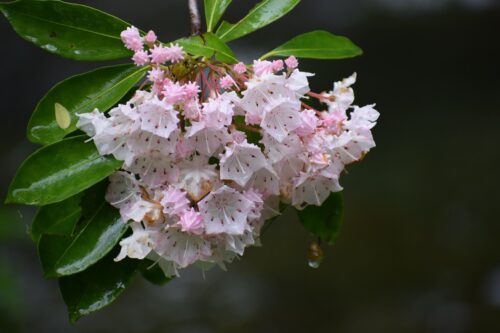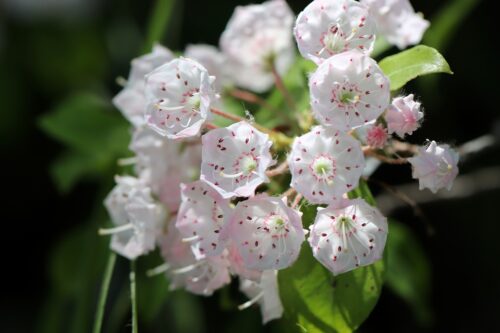Learn How to Grow and Care for Connecticut State Flower with this comprehensive guide to maintain its beauty effortlessly.
Discover How to Grow and Care for Connecticut State Flower; this guide unveils straightforward steps to ensure the flourishing growth and health of the magnificent blooms.
Learn How to Grow Florida State Flower
What is the Connecticut State Flower?
Connecticut State Flower: Mountain Laurel
Family: The Connecticut state flower Mountain Laurel (Kalmia latifolia) belongs to the heath family, Ericaceae. This family includes various flowering plants commonly found in acidic and infertile soils.
Native Place: Mountain Laurel is native to South Carolina. It thrives in woodland areas and can often grow along the edges of forests and in hilly regions.
Appearance: This evergreen shrub features clusters of delicate, bell-shaped flowers. The flowers have a distinct beauty, with shades ranging from white to pale pink and even deep rose. The glossy, dark green leaves provide an attractive backdrop to the flowers.
Blooming Season: Mountain Laurel typically blooms from late spring to early summer, usually around May to June. During this period, the shrub becomes adorned with stunning flowers, creating a picturesque scene in the wild.
Significance: The Mountain Laurel holds cultural significance in Connecticut and is admired for its natural beauty. It symbolizes endurance and strength, as it thrives in challenging conditions, reflecting the state’s and its residents’ spirit.
Legislation: The Mountain Laurel was designated as the official state flower of Connecticut on May 21, 1907. This recognition showcases the importance of this flower to the state’s identity and natural heritage.
Origin: The name “Mountain Laurel” originates from its preferred habitats in mountainous regions. The term “laurel” is used due to its resemblance to the European bay laurel, even though the two plants are not related.
Remember, the Mountain Laurel is treasured in Connecticut because of its unique beauty and what it represents for the state and its people.
Read about Illinois State Flower
How to Grow Connecticut State Flower (Mountain Laurel)
Methods to Propagate Connecticut State Flower (Mountain Laurel):
- Seed Propagation
- Cutting Propagation
- Layering Propagation
Easiest Method: Seed Propagation
Seed propagation is one of the easiest ways to grow Connecticut’s State Flower, the Mountain Laurel. Here’s how you can do it:
The best Time for propagation: Late fall to early winter.
- Collect ripe Mountain Laurel seeds in the late summer or early fall. Look for dry, brown seed capsules that have already split open. Each capsule contains several small seeds.
- Fill small pots or seed trays with a well-draining potting mix.
- Place the small Mountain Laurel seeds on top of the soil in the pots or trays. You don’t need to bury them; they’re tiny, and just pressing them lightly into the soil is enough.
- Press the seeds into the soil and cover the pots or trays with a clear plastic lid or wrap. This creates a mini greenhouse. Mist the soil lightly with water to keep it moist.
- Place the pots or trays in a warm and bright location, but avoid direct sunlight. A windowsill with indirect light is a good choice. Mountain Laurel seeds need warmth to germinate.
- Check the pots or trays regularly to ensure the soil stays moist but not waterlogged. You should see tiny seedlings emerging in a few weeks to a couple of months.
- Once the seedlings have grown a bit and have a few sets of leaves, they can be transplanted into larger pots or directly into your garden.
Tip: Choose a spot with partial shade and acidic soil.
Pot Size for Growing Connecticut State Flower
For growing the Connecticut State Flower (Mountain Laurel) in pots, start with an 8-10 inch diameter pot for initial planting. Choose a well-draining potting mix with added peat moss for acidity. Repot every 2-3 years into a slightly larger pot. Use a mix of potting soil and perlite for optimal drainage.
CHECK OUT New Hampshire State Flower
Ideal Growing Conditions for Connecticut State Flower
Sunlight
The Connecticut State Flower, Mountain Laurel, thrives in partial shade. Plant it where it gets morning sun and afternoon shade. Avoid harsh afternoon sunlight, as it can scorch the leaves. If growing indoors, place it near a bright window with filtered sunlight. Regular watering and mulching are essential for its well-being.
Soil
It thrives in well-draining, acidic soil with a pH of 4.5 to 5.5. Amend the soil with organic matter like peat moss or compost to improve drainage and acidity. A mix of 2 parts soil, 1 part peat moss, and 1 part perlite promotes robust growth and flowering.
Watering
Mountain Laurel grows well in well-draining, acidic soil with a pH of 4.5 to 5.5. Amend the soil with organic matter like peat moss or compost to improve drainage and acidity. A mix of 2 parts soil, 1 part peat moss, and 1 part perlite promotes robust growth and flowering.
Temperature
The Connecticut State Flower, Mountain Laurel, prefers moderate temperatures. It thrives in USDA hardiness zones 5 to 9. The ideal temperature range is around 60 to 75°F (15 to 24°C) during the growing season. Protect the plant from extreme cold and frost, especially in colder zones, to ensure its health and growth.
Note: In regions with very cold weather, consider using burlap or frost cloth to cover the Connecticut State Flower during winter. This shields it from harsh winds, safeguarding both leaves and buds from potential damage.
Learn How to Grow and Care for Arizona State Flower
Connecticut State Flower Care

Fertilizer
Feed the Connecticut State Flower using a balanced, slow-release fertilizer designed for plants that enjoy acid-loving soil. Apply in early spring before new growth starts and once more in late spring after the blossoms fade. Be cautious with nitrogen; too much can encourage leaf growth instead of flowers.
Pruning
Pruning the Mountain Laurel helps maintain its shape and health. After flowering in late spring, trim back any faded blossoms to encourage new growth. To rejuvenate an older plant, perform a rejuvenation pruning by cutting back up to one-third of older branches. Avoid heavy pruning in fall, as it can affect next year’s blooms.
Pests and Diseases
Mountain Laurel (Kalmia latifolia), the Connecticut State Flower, can face certain pests and diseases. Some common ones include:
Pests:
- Rhododendron Borer: These insects bore into stems, causing wilting and dieback. Regularly inspect and prune affected branches.
- Azalea Caterpillar: The caterpillars chew on leaves, defoliating the plant. Handpick them or use natural predators like birds.
- Scale Insects: These small, immobile insects attach to stems and leaves, sucking sap. Use horticultural oil to control infestations.
Diseases:
- Leaf Spot: Fungal infections can cause circular, discolored spots on leaves. Remove affected leaves and ensure good air circulation.
- Powdery Mildew: A white powdery substance on leaves can hinder growth. Plant in well-spaced areas, prune for better air circulation and use fungicidal sprays if needed.
- Phytophthora Root Rot: This soil-borne fungus causes root decay. Plant in well-draining soil and avoid overwatering.
Important Tips:
Maintain a healthy Mountain Laurel by caring for its soil, water, and spacing. Regularly inspect for pests and diseases. Ensure proper sunlight and air circulation, encourage beneficial insects, and trim dead branches. As a last resort, apply insecticides or fungicides responsibly, adhering to guidelines. Preventive measures and vigilance are key for a thriving plant.
Learn How to Grow Texas State Flower
Connecticut State Flower – FAQs
Q1: Can I grow Connecticut State Flower (Mountain Laurel) in a pot?
A: Yes, you can. Choose a pot with good drainage and acidic potting mix. Repot every 2-3 years into a slightly larger container.
Q2: Are there any specific companion plants that go well with Mountain Laurel?
A: Plants like ferns, azaleas, and rhododendrons make great companions for Mountain Laurel, as they share similar soil and shade preferences.
Q3: Can I propagate the Connecticut State Flower from cuttings?
A: Yes, you can. Take semi-hardwood cuttings in summer, dip them in rooting hormone, and plant them in a well-draining medium. Keep them consistently moist until they root.
Q4: What should I do if I notice yellowing leaves on my Mountain Laurel?
A: Yellow leaves can indicate various issues like nutrient deficiencies or overwatering. Check soil moisture, adjust watering, and consider soil amendments if needed.
Q5: Can I use mulch around my Mountain Laurel?
A: Yes, mulch helps retain moisture, regulate soil temperature, and prevent weed growth. Apply a layer of organic mulch around the plant, but avoid piling it against the stem.






